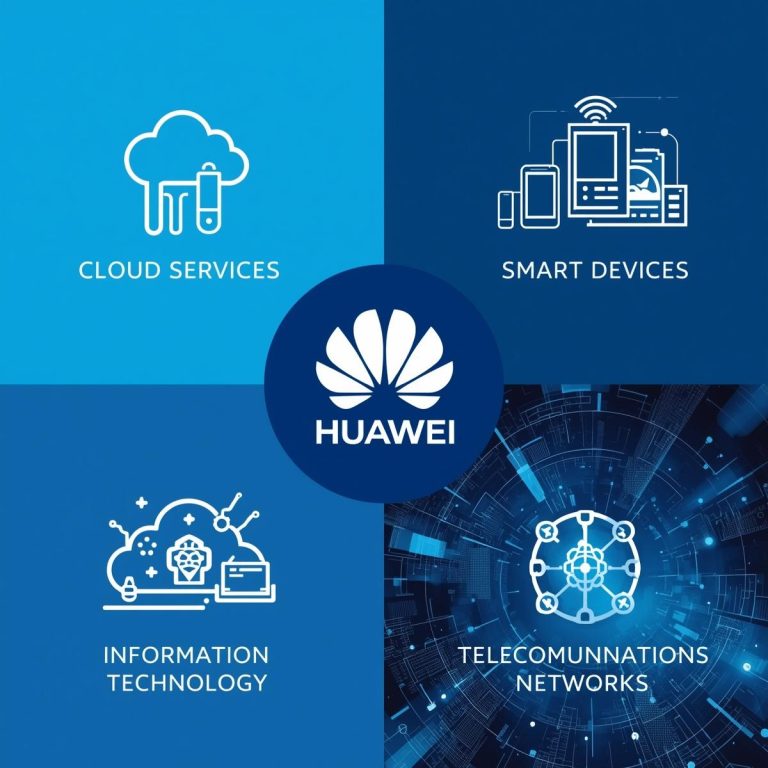
HUAWAI CASE STUDY

Introduction
The corporation known as Huawei Technologies Co., Ltd. is based in China. These days, Huawei is becoming a highly well-known firm all over the world as a result of the high technological quality of its goods and the innovations it has introduced. The Chinese corporation in question is the most prominent provider of information and communications technology infrastructure as well as intelligent gadgets on a global scale. by providing integrated solutions across four essential sectors, namely cloud services, smart devices, information technology, and telecommunications networks.
Huawei is dedicated to bringing digital technology to every individual, household, and business in order to create a world that is completely connected and intelligent. The purpose of our proposal is to investigate the international techniques that Huawei has been utilizing to achieve their achievement. What distinguishes this corporation from its rivals? Can you explain why clients or customers would choose Huawei over other organizations that are recognized for their technological capabilities? And what are some ways in which they might enhance their business in order to increase the number of customers they serve, as well as to expand their reach into new areas and make their products more competitive?
The manner in which Huawei Technologies had made strategic decisions regarding when and how to enter an established market that was in a state of intense competition is the subject of a comprehensive study. In addition to this, the study investigates the significant aspects of their business model, which include the precise pricing strategy, market segmentation, and the moment at which they entered the market.
- Company profile
Huawei is a privately held firm that has more than 180,000 workers and conducts business in more than 170 countries across the globe. Huawei is a significant global provider of information and communication technology infrastructure as well as smart devices. They offer cloud services, smart devices, infrastructure for telecommunications networks, and information technology. Their goal is to fulfill their commitment to providing digital technology to every individual, household, and business in order to create a world that is fully linked and intelligent.
They have a vision and objective to bring digital to every person, home, and organization in order to create a world that is fully linked and intelligent, and at the moment, they are concentrating on information and communication technology (ICT) and intelligent gadgets.
According to Interbrand International, a renowned worldwide brand consultancy, Huawei experienced a growth of 21% in 2018, which allowed the company to move up to the 68th position on the list of top value companies available around the world. This year, Huawei moved up two spots from the rankings from the previous year, and the company’s brand worth increased by 14%, which is equivalent to an estimated 7.6 billion US dollars.
A number of nations, including Silicon Valley and Dallas in the United States of America, Stockholm in Sweden, Moscow in Russia, Bangalore in India, and Beijing, Shanghai, Nanjing, Shenzhen, Hangzhou, and Guangzhou in China, are home to Huawei’s research and development facilities on a global scale.
- Background
Huawei Technologies is the foremost global provider of telecommunications technologies and the second largest privately held firm in China, with a vision “To enrich life through communication.” Huawei has established itself as one of the most active, rapidly expanding, and inventive global technology firms today. Their tactics have enabled the company to attain a status as one of the most significant and esteemed firms globally, behind Apple and Samsung. Moreover, their communication channels and logistics have also contributed to Huawei’s development and facilitated its expansion into new areas.
Huawei is a worldwide telecommunications solutions supplier primarily centered on customer requirements and innovation. With its distinctive comprehensive provision of equipment in Telecom Networks, Global Services, and Devices, it has garnered a global reputation in wireline, wireless, and IP technologies, serving roughly one-third of the world’s population.
The objective was to enhance customers’ lives via communication. It had surpassed Ericsson, another global telecommunications competitor, in its expansion endeavors. However, Huawei’s globalization initiatives were hindered by security apprehensions voiced by nations dubious of its transparency deficiencies. The United States has strongly opposed Huawei’s expansion efforts within its borders. For Huawei to attain the status of a genuinely global enterprise, it was imperative to cultivate its market presence in the United States. This case study will examine Huawei’s expansion in China, its foreign growth initiatives, and the potential impact of US security concerns on its global development.
- Entry mode to different markets
Different entry modes have been developed by Huawei, depending on the geographical distance between countries, different markets, and different products. Huawei is constantly thinking about the needs of their customers and what they can do to satisfy those needs and make them possible to obtain for all people around the world. As a result, Huawei is also competing in terms of price. Among these unique approaches are the following:
In the Russian market, a joint venture. The market selection strategy employed by Huawei focuses on expanding into markets that have a limited telecommunications infrastructure but have significant potential for growth.
Export entry mode in countries such as south America, Asia and Africa, Huawei use the export method as an input mode, due to factors of great influence on both sides, these factors such as geographical distance and local market conditions, within this point is important to highlight that in countries such as Colombia, Huawei just offer smartphones and tablet, they have not exporting laptops and some others products they use to offer, the price also plays an important role within countries like Colombia, Ecuador and some others, because the products are high quality ones and consider as luxury and they are not as expensive as some others brand, so Huawei have gained lot of market within this countries.
There is a different entry mode for North America, Huawei had to face some challenges in order to penetrate this market, so they decided to use the same strategy to get into the American market as the one they use in west Europe, this method include franchising, co-research, co-production (OEM) and co-sales( helping each other to sell products in each of their own markets), the table below reflects these alliances
Additionally, Huawei utilizes a variety of entrance techniques in a flexible manner for a variety of products, particularly those that do not offer any advantages. For example, in the field of 2G mobile networks, Huawei used to collaborate with established companies. In addition, the company employs the methods of joint ventures, franchising, or co-research for the products that they feel to be advantageous. These products have a technological advantage but do not have any commercial resources. Furthermore, Huawei’s astute strategy of brand collaborations throughout its development has been a crucial contributor to the company’s emergence from a regional player to a worldwide leader.
- Promotional channels
According to Huawei, its services and products are currently being utilized in close to one hundred and forty nations all over the world. Additionally, the company provides its services to the five leading telecom sector operators in the global market.
76,000 of the company’s 170,000 employees are employed in the research and development department, which is responsible for ensuring that the company’s operations are carried out in an effective manner. China, Canada, the United States of America, Pakistan, Germany, Sweden, Colombia, Turkey, Russia, and other countries are among the countries that Huawei has established 21 research and development institutions in.
From the beginning, Huawei’s distribution channels have consistently been exceedingly efficient. It has a strong belief in the development of joint ventures with local authorities, and as part of this connection, it offers dividends to local authorities in exchange for their use of Huawei goods.
Due to the fact that Huawei believes in building an appropriate route of distribution that comprises distributors, sales networking team, enterprise, and consumers, the brand Huawei does not currently deal directly with customers. At this point in time, it is of utmost significance for the corporation to produce a certain quantity of products on a specific day at a specific location. Location, market coverage, mobile phones, and the online market are all examples of what place refers to. It possesses two channels that are quite important. In the first place, there is a seller’s channel that establishes an office in the target market for the purpose of direct product sales. In the second place, there is a joint venture that is used to construct additional brand channels.
- R&D Management System
The groundwork for all other advancements at Huawei is provided by their innovative management. To quickly seize fleeting market opportunities, the organization has implemented R&D management methods and fortified the support of its common platforms. A technology sharing system comprising multiple levels such as system design, platform, modules, and components has been built by Huawei with CBB, a hardware and software sharing module.
In addition to streamlining their processes and organizational framework to avoid technology leaks, Huawei advocates for standardized, component-based, and platform-specific management in their R&D. Huawei manages the time-to-market of goods, speeds up their response time to market demands, and organizes development progress at multiple levels using an asynchronous new product development process. Final product delivery is often possible within four days after contract signing. As a major competency, Huawei integrates breakthroughs in numerous sectors, which allows it to achieve the top in its field.
- Market Share of Huawei
Global Smartwatch Shipments Market Share, Q2 2024 vs Q2 2025

Source Image: https://counterpointresearch.com/en/insights/global-smartwatch-market-q2-2025
Apple will take the top spot in worldwide shipment leadership for the first time. With more than three-quarters of its shipments centered in China and the bulk of its portfolio priced between $100 and $400, Huawei continues to provide a compelling range of smartwatches that appeal to a wide spectrum of consumers. Beyond that, Huawei has been gradually increasing its presence in other regions such as Europe, Middle East, and Asia Pacific in order to broaden its worldwide customer base. Its growing smartphone user base in China, combined with its integrated ecosystem strategy, fueled this expansion.”
At the same time, Apple’s worldwide smartwatch shipments fell for the seventh consecutive quarter, resulting in the brand losing its position at the top of the global market. Nevertheless, it maintained its position at the forefront of the advanced smartwatch market, supported by the robustness of its iOS ecosystem and enduring user loyalty.
Xiaomi and Imoo experienced significant growth in their shipments during the quarter, each effectively targeting unique market segments among the top five players. Xiaomi dominated the basic smartwatch market, propelled by its focus on value and extensive geographic presence. Meanwhile, Imoo maintained its stronghold in the kids’ smartwatch market, utilizing its unique features and solid brand reputation among both young users and their parents. Samsung, a significant contender in the global market, experienced a 3% year-over-year decrease in shipments. The recent declines for both Apple and Samsung were largely influenced by consumers delaying purchases in expectation of new-generation devices anticipated to debut in Q3 2025.
- Huawei Core Values:
- Customers Come First: Huawei exists to meet the needs of its customers, whose wants and needs drive our growth. Our buyers always get long-term value from us because we listen to their needs and wants. Because we can only be successful if our customers are successful, we judge our work by how much worth we bring to them.
- Dedication: Customers value and trust us because we work hard at what we do. It includes everything we do to make our services better and give our users more value. We appreciate what our employees do and reward them properly.
- Always Getting Better: We need to keep getting better so that we can be better partners for our customers, make our business better, and grow as people. To get better, we have to constantly listen and learn during this process.
- Be open and take the lead: Because we care about what our customers want, we are always looking for new ways to make things better for them. We think that business success is the best way to judge the worth of any new technology, product, solution, or method.
- Being honest: Honesty is the most important thing we have. We are honest and keep our promises because we want to earn the trust and respect of our customers.
- Working together: We can only do well if we work together. By working together closely through good and bad times, we set the stage for successful cross-cultural teamwork, streamlined departmental cooperation, and processes that work well.
- Human resources
Ren Zhengfei is the principal shareholder of Huawei, possessing a 1.4% stake. The remaining 98.6% is owned by Huawei personnel. By the conclusion of 2014, out of 170,000 employees, 80,000 possessed an equity interest in the company, with no external stakeholders present.
Interviews with over 100 Huawei executives indicate that the majority endorse the employee shareholding arrangement, fostering a collective ownership mentality of “fighting the fight together.”
- Finance
Based on the exchange rate at the end of that reporting period, Huawei’s revenue for the first half of 2018 was 325.7 billion yuan, or approximately $49 billion. Based on year-end exchange rates, the Chinese company recorded $92.5 billion in revenue for the entire year 2017.
Strong success in a number of industries, particularly the consumer sector, which has been steadily increasing, has been the main driver of the expansion thus far. By market share, Huawei has surpassed Apple to become the second-largest smartphone manufacturer in the world.
- Challenges and competition analysis
Despite Huawei’s remarkable success over the past three decades, it faces distinct business obstacles. In the rapidly evolving digital and technology sector, it remains crucial for Huawei to prioritize innovation within its strategy.
Despite maintaining an innovative trajectory, Huawei confronts numerous challenges stemming from intense competition within the industry and the historical failures of comparable enterprises. History demonstrates that monopolistic dominance is ephemeral; structural dynamics in every sector have evolved and will persist in changing, as exemplified by BlackBerry’s decline from its former prominence. The foremost error of successful organizations is complacency. For Huawei, merely advancing research and development is inadequate. Nokia allocated tenfold resources to R&D compared to Apple over an extended duration, erroneously focusing on items that catered to its primary market segment while neglecting the limited consumer interest in prospective touch-screen technology. Likewise, Huawei must consistently endeavor to fulfill and anticipate future consumer demands rather than merely addressing present ones. Moreover, a current benefit of Huawei is its status as a wholly employee-owned private enterprise, which will undoubtedly draw interest from investors seeking to capitalize on its remarkable growth.
A significant challenge Huawei encountered in its transition from a Chinese technological firm to a global entity was its brand image in the United States, where the most formidable obstacle in Huawei’s global strategy was the disparagement campaign orchestrated by the U.S. government. Intelligence officials have advised American companies against engaging in business with Huawei owing to probable Chinese state influence and security apprehensions. Furthermore, this company has been actively seeking an opportunity to expand into North America, which constitutes approximately 20% of global telecommunications expenditure. Since a 2007 article revealed CEO Ren Zhengfei’s military history, Huawei has been designated as a political target. Prior to establishing Huawei in 1987, Ren served as a civil engineering director for the Chinese military. Huawei presently supplies telecommunications equipment to prominent Internet service providers, who then transmit data for nearly all government entities. The U.S. intelligence committee advised that American telecommunications companies refrain from engaging in business with Huawei due to probable Chinese governmental influence and security risks.
In response, Huawei has initiated a strategic outreach to analysts, journalists, and lawmakers to alleviate doubts. Huawei additionally revealed the constituents of its Board of Directors. The aforementioned B2B problems partially elucidate why the smartphone is poised to be pivotal for Huawei’s expansion in America. Huawei cannot concede defeat or entirely relinquish the U.S. market, as it constitutes approximately 20% of worldwide telecommunications expenditure. Although it need not dominate the U.S. market, it must gain acceptance as it expands as a smartphone brand. If Huawei executes this effectively, it may serve as a substantial demonstration of corporate citizenship and secure the brand a position among other prominent Asian technology companies in the United States, including Samsung, Lenovo, and LG. Going forward, Huawei should disclose further financial and corporate information to enhance openness.
Huawei has initiated a deliberate effort to enhance international and diverse experience within its managerial ranks, encompassing both Board and various senior and mid-management positions. This strategy has facilitated the company’s transition towards a brand-oriented global leadership. Additionally, Huawei has begun recruiting prominent Western executives to diversify its senior management team. This plan must be executed comprehensively to ensure that different, global perspectives and experiences are deeply integrated into the organization’s structure. A genuinely international senior management team is crucial for Huawei’s success in outside markets.
- Conclusion
The conclusion is that a significant portion of Huawei’s success can be attributed to the implementation of an appropriate and well-chosen strategy to penetrate new markets and develop their business around the globe. The strategic decision that the company made, as well as their policies and practices, served to analyze and identify the advantages that the company will have if they use different entry modes to penetrate specific markets with a large portfolio of their products. These factors contributed to the rapid growth of the company, which ultimately resulted in the company becoming one of the most important and recognized brands in the technological sector all over the world.
The partnership that Huawei has formed with the LEICA camera company and the utilization of their technology to enhance the camera capabilities of Huawei’s smartphones to compete with products like the iPhone and Samsung Galaxy’s is a noteworthy aspect that should be highlighted. This partnership has added value to Huawei’s smartphones, which is a result of the company’s desire to innovate at a rapid pace. In order to fine-tune each of those components, make design decisions, and develop the entire photography experience of Huawei phones, Leica and Huawei have a team of engineers who are dedicated to working together.
However, the most important factors that contributed to the company’s success in overcoming these challenges were the constant analysis of the environment and the well-understood and known industry and sector. This caused the company to improve their practices and find a solution to their situation. Despite the fact that the company has presented moments of difficulty and challenges, one of the most relevant ones will be the American case.




